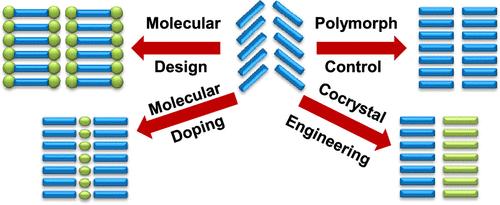Rational Control of Packing Arrangements in Organic Semiconducting Materials toward High-Performance Optoelectronics
IF 14
Q1 CHEMISTRY, MULTIDISCIPLINARY
引用次数: 0
Abstract
Organic semiconducting materials have sparked a great deal of interest because of their structural versatility, lightweight, mechanical flexibility, as well as low temperature and large area fabrication, opening up possibilities for the development of next-generation electronic devices. Packing arrangements of organic semiconducting materials influence significantly the optoelectronic performance by alteration of electronic couplings, band structures, and exciton behaviors. The packing structures of small-molecule organic semiconductors can be typically classified into herringbone, slipped, and brickwork motifs. The preferred packing arrangement depends on the steric hindrance driven by the molecular structure and the weight of contribution of each interaction term, which are closely associated with the unpredictable and uncontrollable process of crystal nucleation and growth, involving lots of multiple variables such as the weak and subtle intramolecular or intermolecular interactions in organic materials. Therefore, it remains a long-standing challenge to tailor precisely the packing arrangements for high-performance or multifunctional organic semiconducting materials. In addition, the in-depth relationship between packing arrangements and optoelectronic properties is far from clear, preventing the development of high-performance organic optoelectronic materials.

合理控制有机半导体材料中的填料排列,实现高性能光电子学
有机半导体材料因其结构多变、重量轻、机械柔性好、可低温大面积制造等特点而备受关注,为下一代电子器件的开发提供了可能。有机半导体材料的填料排列会改变电子耦合、带状结构和激子行为,从而对光电性能产生重大影响。小分子有机半导体的堆积结构通常可分为人字形、滑动和砖砌图案。优选的填料排列取决于分子结构驱动的立体阻碍和各相互作用项的贡献权重,这与不可预测和不可控制的晶体成核和生长过程密切相关,涉及有机材料中微弱和微妙的分子内或分子间相互作用等多种变量。因此,如何为高性能或多功能有机半导体材料量身定制精确的填料排列仍然是一项长期的挑战。此外,填料排列与光电特性之间的深入关系也远未明确,阻碍了高性能有机光电材料的开发。
本文章由计算机程序翻译,如有差异,请以英文原文为准。
求助全文
约1分钟内获得全文
求助全文

 求助内容:
求助内容: 应助结果提醒方式:
应助结果提醒方式:


